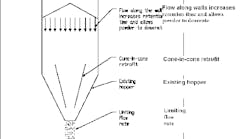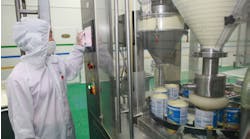When a fine powder traps air between particles, it may exit a bin like it is in a pneumatic conveyor system, shooting through any crack or crevice, including poorly fitting or worn rotary valve vanes, screws, feeders, bolt holes, vibratory feeder pans or belt feeders, until the powder is depressurized. Yet once the powder settles and air is squeezed from voids between powder particles, it can plug feeders, arch over hopper outlets or cling to hopper walls and form a stable rathole, which creates equally unstable process conditions downstream.
Talc, lime, powder cleansers, fly ash, pulverized coal, resin, plastic powders, iron ore and cement are most susceptible to flooding and flushing.
The culprits
The interaction of powder and air cause flooding and flushing problems they always require a source of pressurized air. Some of these sources include collapsing ratholes, back-pressure from baghouses, free-falling powder, air pads, improperly set air permeation units, rotary valves that feed pressurized pneumatic conveying systems (especially those that are not vented), and gas/solids units with gas counterflow. The three most common sources, however, are collapsing ratholes, free-falling powder and uncontrolled air injection.
Collapsing ratholes. The most frequent source of powder flushing is a flow pattern within a hopper that results in a rathole (Figure 1).
Usually this happens in conical hoppers when hopper walls are not steep enough to cause flow along the walls. As a result, flow is directed to a narrow central flow region while non-flowing material accumulates at the sides and eventually becomes an integral part of the hopper structure. If the rathole collapses or a high rate of powder is then introduced into the hopper, the incoming powder can entrain pressurized air, which will fluidize the powder and result in flushing through screw, belt and vibratory feeders, and even in rotary valves with an entrained air pressure of several psi.
Depending upon the hoppers outlet diameter and the strength of the material, a rathole may become destabilized and can peel off and collapse into the hopper, essentially flushing a large quantity of powder through the outlet and into any feeder below
Free-falling powder. Flushing also results when powder free falls into a hopper in a stream and traps air from the surrounding environment between particles (Figure 2). The faster the powder flows, the larger the void or space between particles, and the greater the entrained air. As the powder accelerates, so does the air. When the powder strikes the top level of material in the bin, some air is dispersed into the atmosphere, creating dust. The rest of the air is trapped within the powder. If the hopper is small, relative to the flow rate out, and if the material within the hopper has a short retention time that doesnt allow the trapped air to escape, fluidized powder can flow at an uncontrolled rate through the outlet.
Uncontrolled air injection. A third cause of flushing is uncontrolled air injection or a chemical reaction within the powder that produces gas (Figure 3). Both can fluidize powder. The only circumstance in which uncontrolled air injection should be considered is in a pneumatic conveying system that transports powder subject to wide fluctuations in feed rate, or into a closed container such as a blow tank that may require a high charge rate to reduce the cycle time.
Tackling the problem
Properly addressing fine powder flooding and flushing starts with testing the materials flow properties to understand how the particular powder interacts with air and what its potential is for flooding and flushing. Often, this indicates that only minimal adjustments are required.
However, the typical approach for controlling or eliminating excess air that leads to flushing is to place a rotary valve at the hopper outlet. Unfortunately, the valves rotating vanes actually pump air into the hopper outlet; so, instead of reducing excess air, the rotary valve supplies additional air. Eventually, the close tolerances between vanes wear down and flushing can occur.
Other ways plants deal with powder flushing are by building a settling chamber at each feeder, increasing a dust collectors capacity, over-filling packages to compensate for occasional underflow, and putting in automatically closing shut-off gates that activate whenever a paddle switch senses flushing.
Fortunately, there are better methods for preventing powder flushing. Potential solutions include: an air permeation system, a sloping let-down chute, a vertical pipe below the hopper, a deaeration cylinder, and hopper retrofits to correct flow patterns. Their costs can vary considerably.
Air permeation system. Powder will not flow at consistently high rates without some entrained air. When totally deaerated, flow rates may fall significantly below the rate required. When totally fluidized with indiscriminate air injection, as may be the case with air pads or pulse jets, the flow rate may increase, but so will the potential for sudden uncontrolled flushing.
An air permeation system with injection nozzles placed at critical positions in the hopper can control both the air pressure and rate of injection, and provide consistently high powder flow rates without the potential for severe flushing. Such a system can replace air lost when a powder compresses and thereby prevent an inrush of air from the outlet that could impede flow. The small amount of air needed to fill voids and increase the flow rate 10 or more times is not enough to create dust or fluidization.
An air permeation system needs to be designed to prevent over-pressure pulses as powder enters the hopper to keep powder from plugging the ports and to ensure powder flows both above and below the system (Figure 4). Careful placement is crucial, as is properly adjusting air-permeation-system settings.
Vertical pipe below the hopper. A vertical, non-converging pipe placed below a hopper designed for flow at the hopper walls can substitute for an air permeation system because it tends to create a vacuum at the hopper outlet that pulls powder out (Figure 5). This solution also increases the flow rate, sometimes by a factor of 10 or more, because the vacuum can be as great as the height of the vertical section multiplied by the powders bulk density.
When using this solution to increase powder flow rates, it is essential to employ a feeder that controls the flow slightly below the limiting rate. Otherwise, the high rate of powder flow created from using the vertical section is sustained only as long as it is full of powder. Once the vertical section empties, the limiting flow rate is governed by the void above it and powder flow can slow dramatically.
Sloping let-down chute. Another reasonably inexpensive solution for powder flushing is an open let-down chute that protrudes into the powder surface at the top of the hopper and prevents air from circulating through and becoming trapped between powder particles, as is the case with a free-falling powder stream (Figure 6). Although powder in the chute accelerates and thins as it descends, air entrainment is reduced or eliminated because powder is in contact with the chute surface. When placing a let-down chute, it is critical that the chute protrude into the surface of the powder so there is absolutely no powder free-fall. Even a free-fall drop of only a few inches can severely aerate a powder and increase its potential for flushing.
Deaeration cylinder. A deaeration section, composed of a perforated interior cylinder and a vented section in a cylindrical outer section, will remove excess air before it causes flushing at the outlet (Figure 7). The best placement of the deaeration section is just above the air permeation region. As the powder drops through the open cylinder bottom, it is re-entrained in the flowing powder below, which keeps holes within the cylinder from plugging. If upper and lower air permeation regions are used, it may be necessary to have a deaeration section in both regions. Generally, the deaeration section will have a pressure regulation device set at approximately the same pressure as the air permeation unit.
Screw feeder. Such a feeder can provide continuous feed without introducing additional air and can also seal against air pressure in the hopper, provided the hopper is properly designed. It can also deaerate powder by squeezing excess air from the compacted material.
In some cases, installing a compacting screw above the hopper to remove air before the powder enters the hopper will work. However, this still requires an open let-down chute to provide surface contact for the descending powder to prevent reaeration. One design includes a weighted flap plate and air disengaging section that seals against most pressures generated by collapsing ratholes.
Hopper retrofits. If a hopper does not produce flow at the hopper walls (commonly called mass flow), retrofitting the existing hopper can eliminate the source of flushing while improving segregation, process flow rates and feeder performance. Although a more expensive option, it is often the most reliable and cost-effective in the long run.
Retrofitting a conical bin outlet with a properly sized small hopper that produces flow along hopper walls or with a small cone-in-cone hopper (Figure 8) allows a high flow rate without flushing. The retrofit must be large enough to eliminate ratholes (flow channel greater than the critical rathole diameter) but small enough to prevent powder over-compaction in the flow channel.
A one-dimensional convergence hopper (Figure 9) reduces flushing potential by increasing the solids contact pressure at the outlet to about two times that of a two-dimensional conical hopper. This increased pressure allows powder flow without excessive voids expansion, thereby reducing the air vacuum created when voids expand. Reducing the vacuum can double or triple the flow rates.
Other solutions include:
keeping the solids level high in the bin;
reducing bearing purge pressure as low as possible or replacing an air purge seal with a packing gland where possible;
venting rotary valves both on the high-pressure return side and at the level where powder enters;
maintaining rotary valves to minimize air leakage;
eliminating air pads; and
introducing process gas higher in the hopper to allow powder below to pressure-seal the hopper.
Success stories
Lets now look at a couple of actual flushing problems and how they were solved.
Fly ash typifies the bimodal flow rates that can occur with fine powder. With entrained or injected air, fly ash flows like water but, when deaerated, it hangs up. Unfortunately, too much air injection causes uncontrolled flow that oscillates from extremely slow or no flow to sudden flushing, and too little air limits the rate.
A company stored fly ash in a 26-ft-diameter bin equipped with a 12-ft-diameter vibrated hopper that fed into a vibratory feeder and from there into a 40-ft-long conveying screw. A rathole frequently formed above the vibrated hopper in one or two quadrants and then collapsed, flushing more than half the fly ash in the bin through the conveying screw and into an adjacent building. This caused a cleanup nightmare.
The company solved its problem using a one-dimensional convergence hopper retrofit equipped with an air permeation system to condition the fly ash and provide controlled, consistent flow. The retrofit hopper was mounted to the lower half of the vibrated hopper, just below the interior baffle. In effect, the one-dimensional convergence hopper with air permeation replaced the vibrating feeder by sending material directly into the conveying screw. This arrangement increased the flow channel and fly-ash retention time in the flow channel to prevent rathole formation.
Cement is another example of a material susceptible to limiting and erratic flow rates. When stored in a bin, it consolidates under its own weight and, when discharged, expands near the outlet, creating an extremely low flow rate, which is often misidentified as an arching condition.
A company that transported cement from barges to shore-side silos used a clamshell crane to unload the cement from the barge to an outside gravity-flow surge hopper that fed twin blow tanks. Because dustiness was a major concern, the crane operator lowered the clamshell to the top of the cement in the surge hopper before depositing his load. Unfortunately, this action compressed the cement, leaving it in a totally deaerated state, pressurizing some of the air trapped in voids between particles and dispersing some of the air from the top of the bin. As the cement was discharged and began to flow, the air entrained in the cement expanded. This reduced the air pressure to less than atmospheric, so air from outside the hopper outlet rushed in to fill the voids, creating an upward force that retarded flow.
The recommended solution was a one-dimensional convergence hopper with controlled air injection. Compared to a conical or two-dimensional hopper, the new unit doubled solids contact pressures at the outlet, which allowed cement flow without excessive voids expansion. A vertical section was added between the hopper outlet and feeder to provide additional suction, which completely eliminated any vacuum at the hopper outlet. As a result, the company increased its cement flow rates by more than an order of magnitude.
As these examples show, you can prevent fine powder flushing.
Lee Dudley is president of Diamondback Technology, Atascadero, Calif. E-mail him at [email protected].


